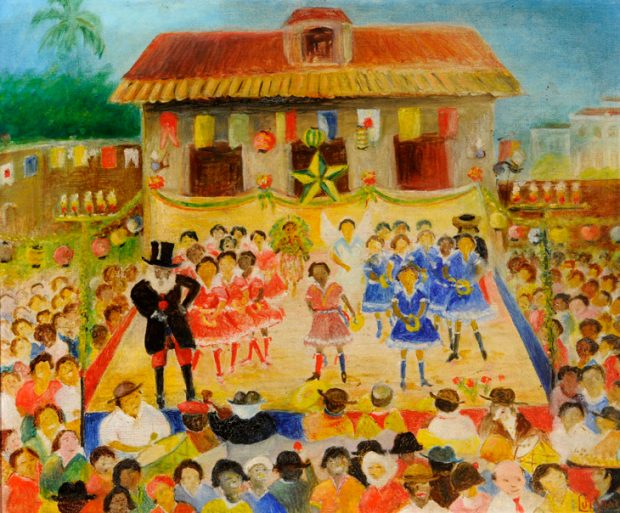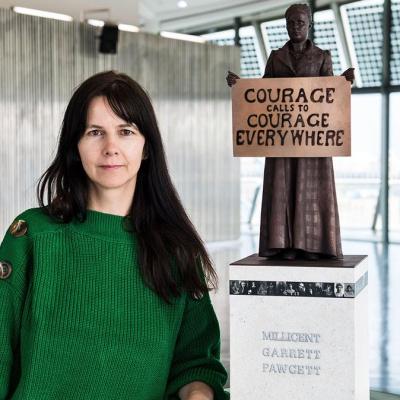There was perhaps one Brazilian artist familiar to the British public in 1944, but she was not represented in the ‘Exhibition of Modern Brazilian Paintings’ that opened at the Royal Academy in November of that year. Certainly, in the case of Sacheverell Sitwell, who wrote the preface to the exhibition catalogue, there was no escaping the looming presence of Brazil’s most famous cultural export, Carmen Miranda. His principal source of knowledge about Brazil – its ‘cargoes of oranges and bananas’, its ‘over fertility’ – seems to have been Miranda’s song ‘Lady in the Tutti Frutti Hat’.
Whether or not they were expecting to encounter the Brazil of Miranda’s films, some 100,000 people trooped through the exhibition at the Royal Academy and the seven regional galleries to which it subsequently travelled. The visitors included Queen Elizabeth, wife of George VI, and her younger daughter, Princess Margaret. Such modernist luminaries as T.S. Eliot and H.G. Wells were invited to its launch. Following the closure of the exhibition, the paintings were sold off to raise money for the Royal Air Force Benevolent Fund. A good number of them were acquired by British museums.
Women of Bahia (n.d.), Emiliano di Cavalcanti. Brighton and Hove Museums and Art Galleries

Some 24 of the 168 paintings that were originally displayed have now been reassembled in the fascinating exhibition ‘The Art of Diplomacy’ at Sala Brasil in London. It represents an admirable feat of historical reconstruction and a rare opportunity to see in one place a broad sampling of Brazilian modernist works on canvas. It also casts an intelligent eye on ‘soft power’ in action, avant la lettre.
The original exhibition opened at a time when German rockets were raining down on London. It represented one step in a lengthy diplomatic tango between Britain and Brazil. The South American country had joined the Allied coalition in 1942, in spite of Churchill’s reservations. Having committed Brazilian troops to the war in Europe, the government of Getúlio Vargas looked for ways to fix a marriage of convenience in the affections of its new partner. One way was through cultural exchange. In 1943 the British Council had sent a consignment of contemporary British artworks to tour South America. Brazil’s foreign minister, Oswaldo Aranha, took steps to emulate this gesture, soliciting works from the country’s leading painters to dispatch to Britain. He hoped that the initiative would demonstrate ‘the effort of all good men against evil, in this war in which everything is at stake, including the freedom of artistic creativity’.
The greatest opponent, it turned out, to the fulfilment of this enterprise was not Hitler’s thought police but the British art establishment. Eluding German U-boats, the ship carrying the works made it safely across the Atlantic. But after reaching London, the paintings languished for months in warehouses while the Foreign Office cast around for a space to hang them. The National Gallery, the Tate and the Victoria and Albert Museum rejected overtures from the government, whose motivation, one official admitted, was ‘a political, not an artistic one’.
Pastoral (c. 1944), Luís Soares. Doncaster Museum and Art Gallery

At first, the elders of the Royal Academy, led by the horse painter Alfred Munnings, were no better disposed. The governing council, wrote Munnings, had scrutinised the works on offer, many of them Expressionist-influenced, and was ‘not favourably impressed’. Eventually the foreign secretary, Anthony Eden, intervened, emphasising the damage to Anglo-Brazilian relations that might ensue ‘as a consequence of an apparent lack of interest or appreciation on our part’. Munnings backed down, through in a grudging letter he reminded Eden that the catalogue should state the origin of the collection, ‘so that no responsibility for its quality will rest on the Royal Academy’.
Munnings’ attitude was more a reflection of the insularity of the Royal Academy than of the accomplishments of the works. A number of the painters represented in the exhibition had already won acclaim in France and the USA, among them Candido Portinari, Lasar Segall and Emiliano di Cavalcanti. Others would go on to achieve later fame – sometimes, as in the case of Roberto Burle Marx, in different disciplines.
Notwithstanding the political impetus behind the exhibition, few of the works address the war directly. A number of the British individuals represented in the British Council exhibition of 1943, such as Paul Nash and William Coldstream, were renowned as war artists, but for their Brazilian counterparts the battlefront remained remote and otherworldly. Even so, the world that emerges from the paintings displayed in the ‘Art of Diplomacy’ is far from the exuberant tropical paradise that Sitwell and others might have envisaged.
For the most part, the paintings offer up the middle-class milieus of São Paulo and Rio de Janeiro. Brazil’s vast hinterland – whether the parched Sertão or the teeming Amazon – goes largely unrepresented. Some of the works on display, most notably di Cavalcanti’s Women from Bahia and Bellá Paes Leme’s Family Group, pay tribute to Brazil’s ethnic diversity, but only Portinari’s mysterious The Scarecrow (The Half-Wit) alludes to the animist traditions pervading rural society.
The Scarecrow (The Half-Wit) (1940), Candido Portinari. The Mercer Art Gallery

The tone of the paintings might have proved equally surprising to British viewers. In the landscapes of Cardoso Júnior and Thea Haberfeld and in the still lifes of Lucy Citti Ferreira and Gastão Worms, the colours are largely muted. In the many portraits on display, by Burle Marx, Segall, José Moraes and Martim Gonçalves, the faces are almost uniformly joyless and the mood is sullen. Even in more colourful works, such as Luis Soares’s Pastoral, which depicts a village festival, and Clovis Graciano’s Ballerina, the figures are expressionless, as though they are mere ciphers performing empty social rituals.
Although the ‘Exhibition of Modern Brazilian Paintings’ was an official enterprise, few of the painters would have called themselves friends of the Vargas government. A number of them, including Portinari and di Cavalcanti, were members of the Communist Party, which Vargas had banned in 1937. They might have been prepared to support the anti-fascist objectives of the war, but they had little enthusiasm for Vargas’s nationalist regime and its populist policies. Only a few of the works here are overtly political – one exception is Manoel Martins’ Suburb, which confronts the poverty, squalor and discomfort endemic in working-class communities – but a sense of disaffection is ubiquitous.
Whatever its effect on British public opinion, the exhibition did score one notable triumph for Brazil. The chargé d’affaires of Peru, who crashed the opening uninvited, was spotted ‘proceeding round the exhibition with a scowl of envy on his face’. What’s the art of diplomacy if it’s not getting one over the neighbour?
‘The Art of Diplomacy: Brazilian Modernism Painted for War’ is at the Sala Brasil Arts Centre, Embassy of Brazil, until 22 June.



